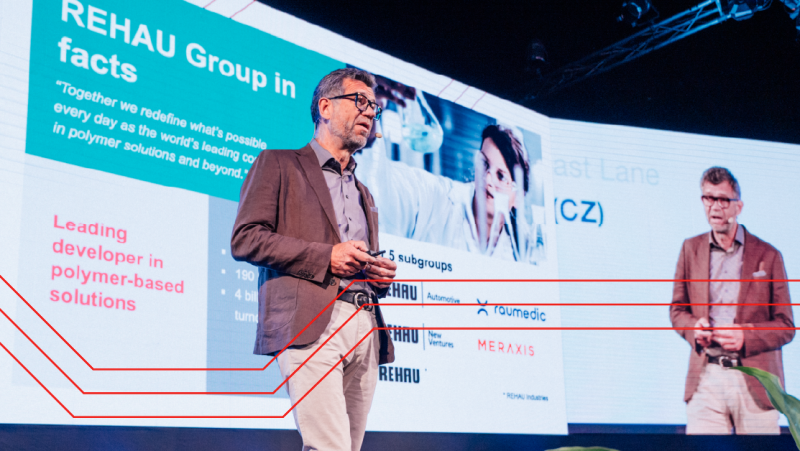BI reporting brings full data automation, says Futaba Czech’s Radek Slanař
- Digital Factory
- Interview
Futaba Czech manufactures steel components for cars. Its Czech plant in Havlíčkův Brod was built to serve as Futaba’s sole location in continental Europe – a role it still retains today. It is also highly valued from this Japanese industrial group’s standpoint because it strives for constant progress in operational management, which oversees logistics, manufacturing, maintenance and more. To achieve defined KPIs and provide precise and timely KPI reporting to its parent company, the plant recently switched to reporting its indicators with the help of BI. What fuelled the plant’s decision, what will the new tool bring it and what are its further visions? We spoke on all this and more with Radek Slanař, this Czech enterprise’s plant manager.
Can you provide some details on Futaba Czech and its manufacturing programme?
We’re an engineering firm owned by the Japanese company Futaba Industrial Co., Ltd. Our speciality is steel products, primarily going out to the automotive industry. They are bodywork, exhausts, dashboard panel braces, and functional components such as chassis sections for automotive axle trees. Our biggest customer is the automaker Toyota Motor Manufacturing Czech Republic (TMMCZ), for which we produce half our output. Our other customers are Toyota (TMMF) in France, Suzuki (MSC) in Hungary and Toyota (TMMT) in Turkey. Our company’s revenue is roughly EUR 360 million, and we employ 1200 people.
What information systems do you use, how do they work and how are they interconnected?
We handle WMS and MES using Aimtec DCIx, for production planning we have the Japanese Asprova APS, for communication with customers we use EDI and we keep our books in the Helios ERP. Customers send us their requests over EDI in the form of daily orders – forecasts. We process this data in the Asprova APS, where we plan production and purchasing and replenish stocks based on the data. We do our production reporting in a MES, which is connected to our current production plan. Purchase orders go out to our suppliers over EDI. We manage our inventory in a WMS, and the data is integrated into the Helios accounting system using receipt and issue slips. We use the “Ignition IT” reporting tool from Inductive Automation and, newly, Microsoft’s Power BI. All the systems are fully integrated, because without EDI, I don’t even know what I’m planning. Without a WMS, I have no information on how much material I need, and without a MES, I have no idea what I’ve produced.
Talking of reporting and expansion to BI, what motivated you to do that? Why did you decide for this shift?
We were making use of Microsoft’s SQL Server Reporting Services on the basis of Excel tables. After the data was exported into Excel, someone had to laboriously sort and edit it. It took a long time; there was a lot of data. We often ended up passing on a day’s data to production up to three days later. Our employees knew they’d made something, but they didn’t know if it was OK and met standards. That led to a state where we couldn’t take the right measures for increasing productivity. Follow-up actions were mostly reactive. We weren’t flexible, and we weren’t able to improve quickly.
Today reporting goes quickly. Report preparation times have been vastly shortened. We’ve saved on the people who had to work with the data before. BI brings us full automation of data processing, including data updating.
Radek Slanař, plant manager, Futaba Czech
What does work with reporting look like at your company today? Have you met your defined goals?
Today reporting goes quickly. Report preparation times have been vastly shortened. We’ve saved on the people who had to work with the data before. BI brings us full automation of data processing, including data updating. Meanwhile the convenience for our users has increased immensely. You open a report, you immediately have the latest data and can concentrate directly on analysis. You’re investigating the thing that happened. You don’t need to do any preparation. BI is able to pull in data from the data warehouse immediately and run a quick visualisation.
We monitor an overall view of the company, with a breakdown by operation and work centre. Previously it was difficult to collect and connect data from individual divisions. With BI it’s easy; even the operators know how they’re doing. We share reports in a group on SharePoint. We see data from the whole company; individual divisions can compare among themselves.

Power BI report, Futaba Czech
We’ve also shortened the time for reporting results to our parent company. In the past we had to do reporting within eight days; now they require a report in four days from the close of the month. We’re capable of meeting these demands. We’re able to work from timely data to carry out corrective measures more quickly as well. We don’t have to wait to see how the month turned out; we can address situations that arise as they happen.
Did you have clear ideas of what you wanted to achieve right from the start?
At the start we didn’t know how we ourselves would process the data in Power BI. We didn’t receive training. We set goals, but in the course of using the reports new requirements arose for how we want to view the data, or based on what criteria we want to filter – for example by products, machine groups or day/night shifts. We thus asked Aimtec to prepare overall production reporting, and thanks to it we could clarify our expectations.
Did you encounter any negative reactions from employees during this tool’s deployment?
A mild distrust reigned among our employees at first. But once we showed them in a few examples of how our reporting works and how the data matches the reality, they began to trust it. People are satisfied to have an overview. Even though we have our data in clear visuals, we do continue to use Excel. In BI we see results, but in new situations we don’t know precisely how we achieved them. That’s why it’s good to continue monitoring raw data from the data warehouse in certain cases and go in deep when something seems off to us.
Are you planning to expand BI reporting into further areas of your plant?
We’d like to also use BI reporting in maintenance. We’re currently working on a project for networking our production lines. We want to collect various information from our machines, for example the configurations of our presses, and their vibrations and temperatures. We’d like to do preventive and predictive maintenance and plan our production based on this data. To digitalise our data from production.
We’re considering notifications. We want to set up the process such that when something happens, the correction occurs immediately. We’d like to have events prepared for handling problems that arise. Today, I know from the data whether a line is or isn’t producing. But if it’s standing still, I can’t tell what’s really happening, whether the malfunction is being addressed or whether we’re waiting. The goals are to achieve full utilisation of our maintenance crew, give them a clear idea of their work and meet defined KPIs.
We’re lacking information on all our people, which we’d like to acquire automatically and have the same clear overview as for our machines. For now, we determine the non-production element of people’s time manually based on records from our attendance system. That’s why we want to integrate its data into the MES and thus gain overall efficiency for our manufacturing, including production, non-production, support and control processes. And that’s the goal I want to reach.
In your opinion, could artificial intelligence (AI) be used in reporting, and if so, how?
My idea is to use AI in reporting for prediction. For us as a manufacturer it would be interesting to see and be able to predict how a production line’s productivity will develop based on the available data. For example whether, at the end of the month, I can improve efficiency further, or no matter what measures I take, the results will be the same, or only just a little better.

Radek Slanař
Radek Slanař works as the plant manager at Futaba Czech. He’s been working at the company since its founding twenty years ago. He’s part of the company’s leadership and oversees all operational management, i.e., logistics, manufacturing and its planning, engineering, maintenance and quality.
Share article
Top stories from logistics, production and IT.
Subscribe to Aimtec Insights
By registering, you agree to the processing of your personal data by Aimtec as described in the Privacy policy.
Get top stories and articles
from Logistics, Production and IT.
Subscribe to Aimtec Insights
By registering, you agree to the processing of your personal data by Aimtec as described in the Privacy policy.







